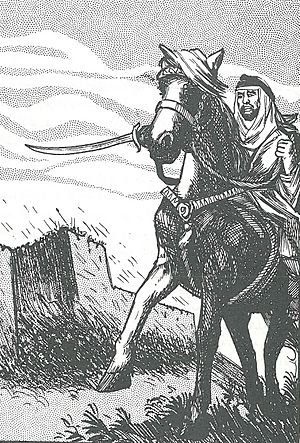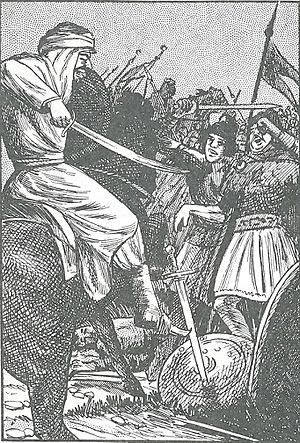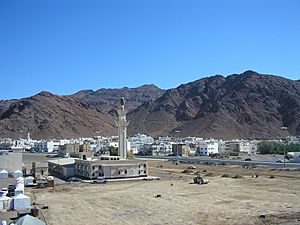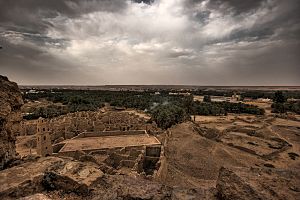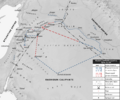Khalid ibn al-Walid facts for kids
Quick facts for kids
Khalid ibn al-Walid
خالد ابن الوليد |
|
|---|---|
 |
|
| Other name(s) | Sayf Allah ('The Sword From The Sword Of Allah') Abu Sulayman |
| Born | Medina |
| Died | 642 Medina or Homs |
| Possible burial place |
The Khalid ibn al-Walid Mosque, Homs, Syria
|
| Allegiance | Quraysh (625–627 or 629) Muhammad (627 or 629–632) Rashidun Caliphate (632–638) |
| Service/ |
Rashidun army |
| Years of service | 629–638 |
| Commands held |
|
| Battles/wars |
|
| Spouse(s) | Asma bint Anas ibn Mudrik Umm Tamim bint al-Minhal |
| Children | Abd al-Rahman Muhajir Sulayman |
Khālid ibn al-Walīd ibn al-Mughīrah al-Makhzūmī (585–642), commonly known as simply Khalid ibn al-Walīd, was an army commander under Abu Bakr and Umar ibn Khattab. It was under his military leadership that Arabia, for the first time in history, was united under a single political entity, the Caliphate.
Khalid ibn al-Walid (Khalid son of al-Walid) was from the Meccan tribe of Quraysh, from a clan that initially opposed Muhammad. He played a vital role in the Meccan victory at the Battle of Uhud against the Muslims.
He converted to Islam, and joined Muhammad after the Treaty of Hudaybiyyah and participated in various expeditions for him, such as the Battle of Mu'tah, which was the first battle between the Romans and the Muslims. Khalid ibn Al-Walid reported that the fighting was so intense, that while fighting, he broke nine swords in the battle. This earned him the title ‘Saif-ullah' meaning "The Sword of Allah"
He captured the Sassanid Arab client Kingdom of Al-Hirah, and defeated the Sassanid Persian forces during his conquest of Iraq (Mesopotamia). He was later transferred to the western front to capture Roman Syria and the Byzantine Arab client state of the Ghassanids.
Although Umar later relieved him of high command, he nevertheless remained the effective leader of the forces against the Byzantines during the early stages of the Byzantine–Arab Wars. Under his command, Damascus was captured in 634 and the key Arab victory against the Byzantine forces was achieved at the Battle of Yarmouk (636), which led to the conquest of the Bilad al-Sham. In 638, he was dismissed from military services.
Khalid is generally considered by historians to be one of early Islam's most seasoned and accomplished generals and he is commemorated throughout the Arab world. The Islamic tradition credits Khalid for his battlefield tactics and effective leadership of the early Muslim conquests.
Contents
Early life
Khalid was born c. 585 in Mecca. His father was Walid ibn al-Mughirah, Sheikh of the Banu Makhzum, a clan of the Arab tribe of Quraysh. Khalid's mother was Lubabah al-Sughra bint al-Harith. Soon after his birth, in accordance with the traditions of the Quraysh, Khalid was sent to a Bedouin tribe in the desert, where a foster mother nursed him and brought him up in the clear, dry and unpolluted air of the desert. At the age of five or six, he returned to his parents in Mecca. During his childhood Khalid suffered a mild attack of smallpox, which he survived, but it left some pockmarks on his left cheek.
| Genealogical tree of Khalid's clan, the Banu Makhzum | |||||||||||||||||||||||||||||||||||||||||||||||||||||||||||||||||||||||||||||||||||||||||||||||||||||||||||||||||||||||||||||||||||||||||||||||||||||||||||||||||||||||||||||||||||||||||||||||||||||||||||||||||||||||||||||||||||||||||||||||||||||||||||||||||||||||||||||||||||||||||||||||||||||||||||||||||||||||||||||||||||||||||||||||||||||||||||||||||||||||||||||||||||||||||||||||||||||||||||||||||||||||||||||||||||||||||||||||||||||||||||||||||||||||||||||||||||||||||||||||||||||||||||||||||||||||||||||||||||||||||||||||||||||||||||||||||||||||||||||||||||||||||||||||||||||||||||||||||||||||||||||||||||||||||||||||||||||||||||||||||||||||||||||||||||||||||||||||||
|---|---|---|---|---|---|---|---|---|---|---|---|---|---|---|---|---|---|---|---|---|---|---|---|---|---|---|---|---|---|---|---|---|---|---|---|---|---|---|---|---|---|---|---|---|---|---|---|---|---|---|---|---|---|---|---|---|---|---|---|---|---|---|---|---|---|---|---|---|---|---|---|---|---|---|---|---|---|---|---|---|---|---|---|---|---|---|---|---|---|---|---|---|---|---|---|---|---|---|---|---|---|---|---|---|---|---|---|---|---|---|---|---|---|---|---|---|---|---|---|---|---|---|---|---|---|---|---|---|---|---|---|---|---|---|---|---|---|---|---|---|---|---|---|---|---|---|---|---|---|---|---|---|---|---|---|---|---|---|---|---|---|---|---|---|---|---|---|---|---|---|---|---|---|---|---|---|---|---|---|---|---|---|---|---|---|---|---|---|---|---|---|---|---|---|---|---|---|---|---|---|---|---|---|---|---|---|---|---|---|---|---|---|---|---|---|---|---|---|---|---|---|---|---|---|---|---|---|---|---|---|---|---|---|---|---|---|---|---|---|---|---|---|---|---|---|---|---|---|---|---|---|---|---|---|---|---|---|---|---|---|---|---|---|---|---|---|---|---|---|---|---|---|---|---|---|---|---|---|---|---|---|---|---|---|---|---|---|---|---|---|---|---|---|---|---|---|---|---|---|---|---|---|---|---|---|---|---|---|---|---|---|---|---|---|---|---|---|---|---|---|---|---|---|---|---|---|---|---|---|---|---|---|---|---|---|---|---|---|---|---|---|---|---|---|---|---|---|---|---|---|---|---|---|---|---|---|---|---|---|---|---|---|---|---|---|---|---|---|---|---|---|---|---|---|---|---|---|---|---|---|---|---|---|---|---|---|---|---|---|---|---|---|---|---|---|---|---|---|---|---|---|---|---|---|---|---|---|---|---|---|---|---|---|---|---|---|---|---|---|---|---|---|---|---|---|---|---|---|---|---|---|---|---|---|---|---|---|---|---|---|---|---|---|---|---|---|---|---|---|---|---|---|---|---|---|---|---|---|---|---|---|---|---|---|---|---|---|---|---|---|---|---|---|---|---|---|---|---|---|---|---|---|---|---|---|---|---|---|---|---|---|---|---|---|---|---|---|---|---|---|---|---|---|---|---|---|---|---|---|---|---|---|---|---|---|---|---|---|---|---|---|---|---|---|---|---|---|---|---|---|---|---|---|---|---|---|---|---|---|---|---|---|---|---|---|---|---|---|---|---|---|---|---|---|---|---|---|---|---|---|---|---|---|---|---|---|---|---|---|---|---|---|---|---|---|---|---|---|---|---|---|---|---|---|---|---|---|---|---|---|---|---|---|---|---|---|---|---|---|---|---|---|---|---|---|---|---|---|---|---|---|---|---|---|---|---|---|---|---|---|---|---|---|---|---|---|---|---|---|---|---|---|---|---|---|---|---|---|---|---|---|---|---|---|---|---|---|---|---|---|---|---|---|---|---|---|---|---|---|---|---|---|---|---|---|---|---|---|---|---|---|---|---|
|
|||||||||||||||||||||||||||||||||||||||||||||||||||||||||||||||||||||||||||||||||||||||||||||||||||||||||||||||||||||||||||||||||||||||||||||||||||||||||||||||||||||||||||||||||||||||||||||||||||||||||||||||||||||||||||||||||||||||||||||||||||||||||||||||||||||||||||||||||||||||||||||||||||||||||||||||||||||||||||||||||||||||||||||||||||||||||||||||||||||||||||||||||||||||||||||||||||||||||||||||||||||||||||||||||||||||||||||||||||||||||||||||||||||||||||||||||||||||||||||||||||||||||||||||||||||||||||||||||||||||||||||||||||||||||||||||||||||||||||||||||||||||||||||||||||||||||||||||||||||||||||||||||||||||||||||||||||||||||||||||||||||||||||||||||||||||||||||||||
The three leading clans of Quraysh at that time were Banu Hashim, Banu Abd ad-Dar and Banu Makhzum, the latter clan being responsible for the matters of warfare. As a member of the Makhzum clan, who were amongst the best horsemen in Arabia, Khalid learned to ride and use such weapons as the spear, the lance, the bow and the sword. The lance was said to be his favorite among the weapons. In youth he was admired as a renowned warrior and wrestler among the Quraysh. Khalid was a cousin of Umar ibn Khattab.
Early military career
Opposition to Muhammad

The Makhzum were strongly opposed to Muhammad, and the clan's preeminent leader Amr ibn Hisham (Abu Jahl), Khalid's first cousin, organized the boycott of Muhammad's clan, the Banu Hashim of Quraysh, in c. 616–618. After Muhammad emigrated from Mecca to Medina in 622, the Makhzum under Abu Jahl commanded the war against him until they were routed at the Battle of Badr in 624. About twenty-five of Khalid's paternal cousins, including Abu Jahl, and numerous other kinsmen were slain in that engagement.
The following year Khalid commanded the right flank of the cavalry in the Meccan army which confronted Muhammad at the Battle of Uhud north of Medina. According to the historian Donald Routledge Hill, rather than launching a frontal assault against the Muslim lines on the slopes of Mount Uhud, "Khalid adopted the sound tactics" of going around the mountain and bypassing the Muslim flank. He advanced through the Wadi Qanat valley west of Uhud until being checked by Muslim archers south of the valley at Mount Ruma. The Muslims gained the early advantage in the fight, but after most of the Muslim archers abandoned their positions to join the raiding of the Meccans' camp, Khalid charged against the resulting break in the Muslims' rear defensive lines. In the ensuing rout, several dozen Muslims were killed. The narratives of the battle describe Khalid riding through the field, slaying the Muslims with his lance. Shaban credits Khalid's "military genius" for the Quraysh's victory at Uhud, the only engagement in which the tribe defeated Muhammad.
In 628 Muhammad and his followers headed for Mecca to perform the umra (lesser pilgrimage to Mecca) and the Quraysh dispatched 200 cavalry to intercept him upon hearing of his departure. Khalid was at the head of the cavalry and Muhammad avoided confronting him by taking an unconventional and difficult alternate route, ultimately reaching Hudaybiyya at the edge of Mecca. Upon realizing Muhammad's change of course, Khalid withdrew to Mecca. A truce between the Muslims and the Quraysh was reached in the Treaty of Hudaybiyya in March.
Conversion to Islam and service under Muhammad
In the year 6 AH (c. 627) or 8 AH (c. 629) Khalid embraced Islam in Muhammad's presence alongside the Qurayshite Amr ibn al-As; the modern historian Michael Lecker comments that the accounts holding that Khalid and Amr converted in 8 AH are "perhaps more trustworthy". The historian Akram Diya Umari holds that Khalid and Amr embraced Islam and relocated to Medina following the Treaty of Hudaybiyya, apparently after the Quraysh dropped demands for the extradition of newer Muslim converts to Mecca. Following his conversion, Khalid "began to devote all his considerable military talents to the support of the new Muslim state", according to the historian Hugh N. Kennedy.
Khalid participated in the expedition to Mu'ta in modern-day Jordan ordered by Muhammad in September 629. The purpose of the raid may have been to acquire booty in the wake of the Sasanian Persian army's retreat from Syria following its defeat by the Byzantine Empire in July. The Muslim detachment was routed by a Byzantine force consisting mostly of Arab tribesmen led by the Byzantine commander Theodore and several high-ranking Muslim commanders were slain. Khalid took command of the army following the deaths of the appointed commanders and, with considerable difficulty, oversaw a safe withdrawal of the Muslims. Muhammad rewarded Khalid by bestowing on him the honorary title Sayf Allah ('the Sword of God').
In December 629 or January 630, Khalid took part in Muhammad's capture of Mecca, after which most of the Quraysh converted to Islam. In that engagement Khalid led a nomadic contingent called muhajirat al-arab ('the Bedouin emigrants'). He led one of the two main pushes into the city and in the subsequent fighting with the Quraysh, three of his men were killed while twelve Qurayshites were slain, according to Ibn Ishaq, the 8th-century biographer of Muhammad. Khalid commanded the Bedouin Banu Sulaym in the Muslims' vanguard at the Battle of Hunayn later that year. In that confrontation, the Muslims, boosted by the influx of Qurayshite converts, defeated the Thaqif—the Ta'if-based traditional rivals of the Quraysh—and their nomadic Hawazin allies. Khalid was then appointed to destroy the idol of al-Uzza, one of the goddesses worshiped in pre-Islamic Arabian religion, in the Nakhla area between Mecca and Ta'if.
Khalid was afterward dispatched to invite to Islam the Banu Jadhima in Yalamlam, about 80 kilometers (50 mi) south of Mecca, but the Islamic traditional sources hold that he attacked the tribe illicitly. In the version of Ibn Ishaq, Khalid had persuaded the Jadhima tribesmen to disarm and embrace Islam, which he followed up by executing a number of the tribesmen in revenge for the Jadhima's slaying of his uncle Fakih ibn al-Mughira dating to before Khalid's conversion to Islam. In the narrative of Ibn Hajar al-Asqalani (d. 1449), Khalid misunderstood the tribesmen's acceptance of the faith as a rejection or denigration of Islam due to his unfamiliarity with the Jadhima's accent and consequently attacked them. In both versions Muhammad declared himself innocent of Khalid's action but did not discharge or punish him. According to the historian W. Montgomery Watt, the traditional account about the Jadhima incident "is hardly more than a circumstantial denigration of Khālid, and yields little solid historical fact".
Later in 630, while Muhammad was at Tabuk, he dispatched Khalid to capture the oasis market town of Dumat al-Jandal. Khalid gained its surrender and imposed a heavy penalty on the inhabitants of the town, one of whose chiefs, the Kindite Ukaydir ibn Abd al-Malik al-Sakuni, was ordered by Khalid to sign the capitulation treaty with Muhammad in Medina. In June 631 Khalid was sent by Muhammad at the head of 480 men to invite the mixed Christian and polytheistic Balharith tribe of Najran to embrace Islam. The tribe converted and Khalid instructed them in the Qur'an and Islamic laws before returning to Muhammad in Medina with a Balharith delegation.
Commander in the Ridda wars
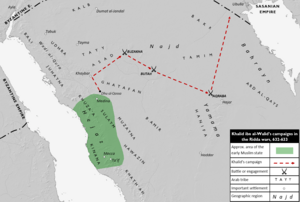
After Muhammad's death in June 632, one of his early and close companions, Abu Bakr, became caliph (leader of the Muslim community). The issue of succession had caused discord among the Muslims. The Ansar (lit. Helpers), the natives of Medina who hosted Muhammad after his emigration from Mecca, attempted to elect their own leader. Opinion was split among the Muhajirun (lit. Emigrants), the mostly Qurayshite natives of Mecca who emigrated with Muhammad to Medina. One group advocated for a companion closer in kinship to Muhammad, namely his cousin Ali, while another group, backed by new converts among the Qurayshite aristocracy, rallied behind Abu Bakr. The latter, with the key intervention of the prominent Muhajirun, Umar ibn al-Khattab and Abu Ubayda ibn al-Jarrah, overrode the Ansar and acceded. Khalid was a staunch supporter of Abu Bakr's succession. A report preserved in a work by the 13th-century scholar Ibn Abi'l-Hadid claims that Khalid was a partisan of Abu Bakr, opposed Ali's candidacy, and declared that Abu Bakr was "not a man about whom one needs [to] enquire, and his character needs not be sounded out".
Most tribes in Arabia, except those inhabiting the environs of Mecca, Medina and Ta'if discontinued their allegiance to the nascent Muslim state after Muhammad's death or had never established formal relations with Medina. Islamic historiography describes Abu Bakr's efforts to establish or reestablish Islamic rule over the tribes as the Ridda wars (wars against the 'apostates'). Views of the wars by modern historians vary considerably. Watt agrees with the Islamic characterization of the tribal opposition as anti-Islamic in nature, while Julius Wellhausen and C. H. Becker hold the tribes were opposed to the tax obligations to Medina rather than Islam as a religion. In the view of Leone Caetani and Bernard Lewis, the opposing tribes who had established ties with Medina regarded their religious and fiscal obligations as being a personal contract with Muhammad; their attempts to negotiate different terms after his death were rejected by Abu Bakr, who proceeded to launch the campaigns against them.
Of the six main conflict zones in Arabia during the Ridda wars, two were centered in Najd (the central Arabian plateau): the rebellion of the Asad, Tayy and Ghatafan tribes under Tulayha and the rebellion of the Tamim tribe led by Sajah; both leaders claimed to be prophets. After Abu Bakr quashed the threat to Medina by the Ghatafan at the Battle of Dhu al-Qassa, he dispatched Khalid against the rebel tribes in Najd. Khalid was Abu Bakr's third nominee to lead the campaign after his first two choices, Zayd ibn al-Khattab and Abu Hudhayfa ibn Utba, refused the assignment. His forces were drawn from the Muhajirun and the Ansar. Throughout the campaign, Khalid demonstrated considerable operational independence and did not stringently abide by the caliph's directives. In the words of Shaban, "he simply defeated whoever was there to be defeated".
Campaigns in Iraq
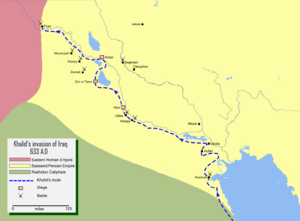
With the Yamama pacified, Khalid marched northward toward Sasanian territory in Iraq (lower Mesopotamia). He reorganized his army, possibly because the bulk of the Muhajirun may have withdrawn to Medina. According to the historian Khalil Athamina, the remnants of Khalid's army consisted of nomadic Arabs from Medina's environs whose chiefs were appointed to replace the vacant command posts left by the sahaba ('companions' of Muhammad). The historian Fred Donner holds that the Muhajirun and the Ansar still formed the core of his army, along with a large proportion of nomadic Arabs likely from the Muzayna, Tayy, Tamim, Asad and Ghatafan tribes. The commanders of the tribal contingents appointed by Khalid were Adi ibn Hatim of the Tayy and Asim ibn Amr of the Tamim. He arrived at the southern Iraqi frontier with about 1,000 warriors in the late spring or early summer of 633.
The focus of Khalid's offensive was the western banks of the Euphrates river and the nomadic Arabs who dwelt there. The details of the campaign's itinerary are inconsistent in the early Muslim sources, though Donner asserts that "the general course of Khalid's progress in the first part of his campaigning in Iraq can be quite clearly traced". The 9th-century histories of al-Baladhuri and Khalifa ibn Khayyat hold Khalid's first major battle in Iraq was his victory over the Sasanian garrison at Ubulla (the ancient Apologos, near modern Basra) and the nearby village of Khurayba, though al-Tabari (d. 923) considers attribution of the victory to Khalid as erroneous and that Ubulla was conquered later by Utba ibn Ghazwan al-Mazini. Donner accepts the town's conquest by Utba "somewhat later than 634" is the more likely scenario, though the historian Khalid Yahya Blankinship argues "Khālid at least may have led a raid there although [Utbah] actually reduced the area".
From Ubulla's vicinity, Khalid marched up the western bank of the Euphrates where he clashed with the small Sasanian garrisons who guarded the Iraqi frontier from nomadic incursions. The clashes occurred at Dhat al-Salasil, Nahr al-Mar'a (a canal connecting the Euphrates with the Tigris immediately north of Ubulla), Madhar (a town several days north of Ubulla), Ullays (likely the ancient trade center of Vologesias) and Walaja. The last two places were in the vicinity of al-Hira, a predominantly Arab market town and the Sasanian administrative center for the middle Euphrates valley.
Al-Hira's capture was the most significant gain of Khalid's campaign. After besting the city's Persian cavalry under the commander Azadhbih in minor clashes, Khalid and part of his army entered the unwalled city. Al-Hira's Arab tribal nobles, many of whom were Nestorian Christians with blood ties to the nomadic tribes on the city's western desert fringes, barricaded in their scattered fortified palaces. In the meantime, the other part of Khalid's army harried the villages in al-Hira's orbit, many of which were captured or capitulated on tributary terms with the Muslims. The Arab nobility of al-Hira surrendered in an agreement with Khalid whereby the city paid a tribute in return for assurances that al-Hira's churches and palaces would not be disturbed. The annual sum to be paid by al-Hira amounted to 60,000 or 90,000 silver dirhams, which Khalid forwarded to Medina, marking the first tribute the Caliphate received from Iraq.
During the engagements in and around al-Hira, Khalid received key assistance from al-Muthanna ibn Haritha and his Shayban tribe, who had been raiding this frontier for a considerable period before Khalid's arrival, though it is not clear if al-Muthanna's earlier activities were linked to the nascent Muslim state. After Khalid departed, he left al-Muthanna in practical control of al-Hira and its vicinity. He received similar assistance from the Sadus clan of the Dhuhl tribe under Qutba ibn Qatada and the Ijl tribe under al-Madh'ur ibn Adi during the engagements at Ubulla and Walaja. None of these tribes, all of which were branches of the Banu Bakr confederation, joined Khalid when he operated outside of their tribal areas.
Khalid continued northward along the Euphrates valley, attacking Anbar on the east bank of the river, where he secured capitulation terms from its Sasanian commander. Afterward, he plundered the surrounding market villages frequented by tribesmen from the Bakr and Quda'a confederations, before moving against Ayn al-Tamr, an oasis town west of the Euphrates and about 90 kilometers (56 mi) south of Anbar. Khalid encountered stiff resistance there by the tribesmen of the Namir, compelling him to besiege the town's fortress. The Namir were led by Hilal ibn Aqqa, a Christian chieftain allied with the Sasanians, who Khalid had crucified after defeating him. Ayn al-Tamr capitulated and Khalid captured the town of Sandawda to the north. By this stage, Khalid had subjugated the western areas of the lower Euphrates and the nomadic tribes, including the Namir, Taghlib, Iyad, Taymallat and most of the Ijl, as well as the settled Arab tribesmen, which resided there.
March to Syria
All early Islamic accounts agree that Khalid was ordered by Abu Bakr to leave Iraq for Syria to support Muslim forces already present there. Most of these accounts hold that the caliph's order was prompted by requests for reinforcements by the Muslim commanders in Syria. Khalid likely began his march to Syria in early April 634. He left small Muslim garrisons in the conquered cities of Iraq under the overall military command of al-Muthanna ibn Haritha.
The chronological sequence of events after Khalid's operations in Ayn al-Tamr is inconsistent and confused. According to Donner, Khalid undertook two further principal operations before embarking on his march to Syria, which have often been conflated by the sources with events that occurred during the march. One of the operations was against Dumat al-Jandal and the other against the Namir and Taghlib tribes present along the western banks of the upper Euphrates valley as far as the Balikh tributary and the Jabal al-Bishri mountains northeast of Palmyra. It is unclear which engagement occurred first, though both were Muslim efforts to bring the mostly nomadic Arab tribes of north Arabia and the Syrian steppe under Medina's control.
In the Dumat al-Jandal campaign, Khalid was instructed by Abu Bakr or requested by one of the commanders of the campaign, al-Walid ibn Uqba, to reinforce the lead commander Iyad ibn Ghanm's faltering siege of the oasis town. Its defenders were backed by their nomadic allies from the Byzantine-confederate tribes, the Ghassanids, Tanukhids, Salihids, Bahra and Banu Kalb. Khalid left Ayn al-Tamr for Dumat al-Jandal where the combined Muslim forces bested the defenders in a pitched battle. Afterward, Khalid executed the town's Kindite leader Ukaydir, who had defected from Medina following Muhammad's death, while the Kalbite chief Wadi'a was spared after the intercession of his Tamimite allies in the Muslims' camp.
The historians Michael Jan de Goeje and Caetani dismiss altogether that Khalid led an expedition to Dumat al-Jandal following his Iraqi campaign and that the city mentioned in the traditional sources was likely the town by the same name near al-Hira. The historian Laura Veccia Vaglieri calls their assessment "logical" and writes that "it seems impossible that Khālid could have made such a detour which would have taken him so far out of his way while delaying the accomplishment of his mission [to join the Muslim armies in Syria]". Vaglieri surmises that the oasis was conquered by Iyad ibn Ghanm or possibly Amr ibn al-As as the latter had been previously tasked during the Ridda wars with suppressing Wadi'a, who had barricaded himself in Dumat al-Jandal. Crone, dismissing Khalid's role in Iraq entirely, asserts that Khalid had definitively captured Dumat al-Jandal in the 631 campaign and from there crossed the desert to engage in the Syrian conquest.
Conquest of Syria
Most traditional accounts have the first Muslim armies deploy to Syria from Medina at the beginning of 13 AH (early spring 634). The commanders of the Muslim armies were Amr ibn al-As, Yazid ibn Abi Sufyan, Shurahbil ibn Hasana and Abu Ubayda ibn al-Jarrah, though the last may have not deployed to Syria until after Umar's succession to the caliphate in the summer of 634, following Abu Bakr's death. According to Donner, the traditional sources' dating of the first Muslim armies' deployment to Syria was behind by several months. It most likely occurred in the autumn of 633, which better conforms with the anonymous Syriac Chronicle of 724, which dates the first clash between the Muslim armies and the Byzantines to February 634. By the time Khalid had left Iraq, the Muslim armies in Syria had already fought a number of skirmishes with local Byzantine garrisons and dominated the southern Syrian countryside, but did not control any urban centers.
Khalid was appointed supreme commander of the Muslim armies in Syria. Accounts cited by al-Baladhuri, al-Tabari, Ibn A'tham, al-Fasawi (d. 987) and Ibn Hubaysh al-Asadi hold that Abu Bakr appointed Khalid supreme commander as part of his reassignment from Iraq to Syria, citing the general's military talents and record. A single account in al-Baladhuri instead attributes Khalid's appointment to a consensus among the commanders already in Syria, though Athamina asserts "it is inconceivable that a man like [Amr ibn al-As] would agree" to such a decision voluntarily. Upon his accession, Umar may have confirmed Khalid as supreme commander.
Khalid reached the meadow of Marj Rahit north of Damascus after his army's trek across the desert. He arrived on Easter day of that year, i.e. 24 April 634, a rare precise date cited by most traditional sources, which Donner deems to be likely correct. There, Khalid attacked a group of Ghassanids celebrating Easter before he or his subordinate commanders raided the Ghouta agricultural belt around Damascus. Afterward, Khalid and the commanders of the earlier Muslim armies, except for Amr, assembled at Bosra southeast of Damascus. The trading center of Bosra, along with the Hauran region in which it lies, had historically supplied the nomadic tribes of Arabia with wheat, oil and wine and had been visited by Muhammad during his youth. The Byzantines may not have reestablished an imperial garrison in the city in the aftermath of the Sasanian withdrawal in 628 and the Muslim armies encountered token resistance during their siege. Bosra capitulated in late May 634, making it the first major city in Syria to fall to the Muslims.
Khalid and the Muslim commanders headed west to Palestine to join Amr as the latter's subordinates in the Battle of Ajnadayn, the first major confrontation with the Byzantines, in July. The battle ended in a decisive victory for the Muslims and the Byzantines retreated toward Pella ('Fahl' in Arabic), a major city east of the Jordan River. The Muslims pursued them and scored another major victory at the Battle of Fahl, though it is unclear if Amr or Khalid held overall command in the engagement.
Death
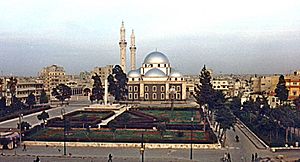
Within less than four years of his dismissal, Khalid died and was buried in 642 in Emesa, where he lived since his dismissal from military services. His tomb is now part of a mosque called Khalid ibn al-Walid Mosque. Khalid's tombstone depicts a list of over 50 victorious battles that he commanded without defeat (not including small battles).
It is said that he had wanted to die as a martyr in the field of battle, and was apparently disappointed when he knew that he would die in bed.
Legacy
Khalid is credited by the early sources for being the most effective commander of the conquests, including after his dismissal from the supreme command. He is considered "one of the tactical geniuses of the early Islamic period" by Donner. The historian Carole Hillenbrand calls him "the most famous of all Arab Muslim generals", and Humphreys describes him as "perhaps the most famous and brilliant Arab general of the Riddah wars and the early conquests". In Kennedy's assessment, Khalid was "a brilliant, ruthless military commander, but one with whom the more pious Muslims could never feel entirely comfortable". While recognizing his military achievements, the early Islamic sources present a mixed assessment of Khalid due to his early confrontation with Muhammad at Uhud, his reputation for brutal or disproportionate actions against Arab tribesmen during the Ridda wars and his military fame which disturbed the pious early converts.
According to the historian Richard Blackburn, despite attempts in the early sources to discredit Khalid, his reputation has developed as "Islam's most formidable warrior" during the eras of Muhammad, Abu Bakr and the conquest of Syria. Kennedy notes that "his reputation as a great general has lasted through the generations and streets are named after him all over the Arab world".
Images for kids
-
Illustration of the Battle of Yarmouk by an anonymous Catalan illustrator (c. 1310–1325).
See also
 In Spanish: Jálid ibn al-Walid para niños
In Spanish: Jálid ibn al-Walid para niños


